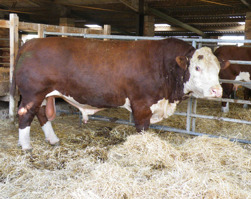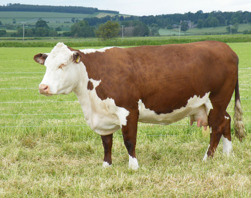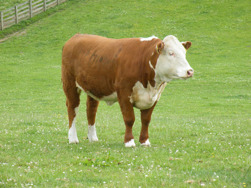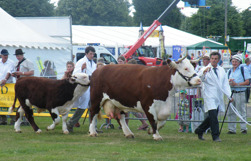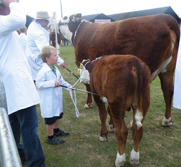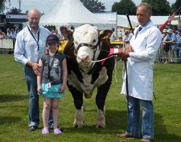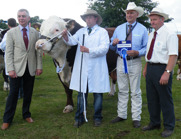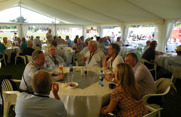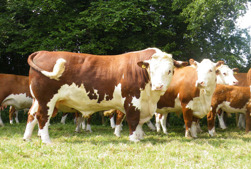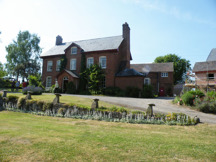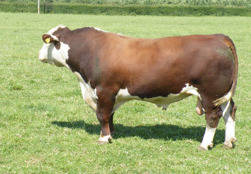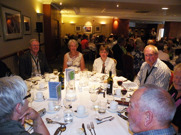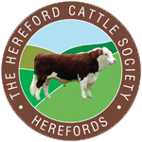
The 13th European Hereford Conference United Kingdom

European Hereford Conference 2010
By Miranda Harding (Lysell)
Secretary of the Swedish Hereford Association and former UK resident
The 13th European Hereford Conference between the 23rd-28th of July. “Building the brand”
Together with my husband Einar and nine year old daughter Christel I flew from Copenhagen till Manchester. Growing up in Cheshire, I have flown to and from Manchester many times, so it’s basically my “home airport”. From there we flew to Edinburgh where we were met by Carolyn Cree the travel coordinator for the UK society and Jill Lewis who was to be our guide.
Later on at the hotel and registrations/mingle buffet, we were greeted by the secretary of the UK society, David Prothero and his assistant, David Deakin. On the run up to the conference I had had quite a lot of contact with David Deakin via e-mail, so I was very happy to meet him at last. We were approximately 75 people at the registration.
Royal Highland Show
We were on site at the Royal Highland Show just after 8am the following morning. This is a show I have wanted to visit all my life. We were shown into the Hereford tent where David Deakin introduced me to Robin Irvine, Chairman of the UK Society. Robin had started Hereford Prime in the UK and I was eager to talk to him about how it all started, as I was hoping to start it in Sweden.

The judge for the day was Jens Michael Jensen from Denmark. We had met Jens Michael on several occasions before and Christel and his daughter Camille, soon got together and went off by themselves to look at other animals at the show.
Unfortunatley I forgot the batteries to my camera in the hotel room! Which is why I don’t have many photos from the show…
Delegates were invited to give out the rosettes which I thought was a lovely gesture from the society which made us feel very welcome and part of it all.
The quality of the cattle was very high. There were many entries in the heifer classes and Jens-Michael did a really good job of sorting through them.
There were only two bulls born in 2007 or earlier. The winner was Romany Captain who later went on to win the Interbreed Championship.
Never having shown cattle in the UK before, but quite a few times in Sweden, there were a couple of things that I found unusual. Firstly, all the beef cattle apart from the small calves were shown with a nose leader. David D told me that it was for safety reasons and at a lot of shows they are compulsory. Thinking about it, I suppose that using a nose leader is much better in the long run than getting dragged around the ring, which isn’t that unusual in the beef classes in Sweden (!)
Secondly, a lot of people showed in rope halters. In Sweden they usually show in horrid chain halters, but more and more are using the rolled dairy halters. I think if the people using the chain halters are not prepared to invest in a rolled dairy halter, then a white rope halter would be a great step in the right direction. The third thing that I found unusual, which I am pretty sure is unique for the UK is that everyone showed in a white coat. I think it is very traditional and in fact, a tradition that should be carried on.
I will definitely promote the nose leaders and white rope halters in Sweden.
The Hereford Show was over by lunch, after which we went for a look around the show until the coach headed back for the hotel. I tried to find rope halters but I could only find a stand that had five, all of which I bought.
We had a look at some horse classes like Hunter Hack for example. Saw some Clydesdales and found some Shetland ponies (which we breed). We were going to go and look at the sheep, but there seemed to be hundreds and time was getting on. Christel said that she had already seen all the sheep anyway… every single one (!)
We had time just to pop in to a handy crafts tent where we found a wonderful print of a Hereford bulls head by Angela Davidsson. The prints were numbered and of each painting there were 395 prints. Jan Wills (Secretary General of the WHC) and one more delegate had bought the same one.
Later on in the evening there was a dinner for all the delegates where Haggis was on the menu. Haggis is a traditional Scottish dish consisting of the stomach of a sheep filled with lung, heart, liver, kidney and suet, onions, crushed oats and spices.
The Haggis was presented in a ceremony, brought in by the chef on a silver tray with sheep horns made out of napkins. A lady dressed in traditional Scottish folk attire, read a poem about the Haggis written for over 120 years ago by a man called Robert Burns. I said no thank you to the sever when he came with my Haggis, but my husband liked it and our daughter ate it all up with great appetite as did her Danish friends!
After the dinner there was a traditional Scottish Tap Dance show.

Romany Herefords
The next day two herd visits awaited us on our way to the next hotel in Telford, Shropshire, about six hours drive south west of Edinburgh. The first stop was at Romany Herefords who have been named the Herd of the Year 2009. We were treated to a very nice brunch and got to see some cattle of the highest quality. I recognised quite a few names in the pedigrees. Especially of the bull SMH Castro who is full brother to one of our ET cows at home, Munka Katie ET, who was named Supreme Champion at the Show in Sweden held in conjunction with the World Hereford Conference in 2008. SMH Castro was bought from Jens-Michael in Denmark. There were a few cows and a bull by Remitall Online. The bull, Romany 1 Asteroid A51 ET caught my eye straight away. He was fantastic! The cattle overall really appealed to me with regards to type.
There were many great calves to be seen, although they were not weighed at birth which was a slight surprise to me I have to admit. But this is greatly what these conferences are all about. Getting to understand how things work in other countries. Robin Ervine told me that there are not many herds that register birth weight at the moment, but that the society had just sent out a weight measuring tape to all members, to encourage them to begin registering the birth weights. The tape is to be placed just above the fetlock joint of a front leg and from that the tape will tell you the estimated birth weight. An inexpensive way to get a birth weight figure.
The visit to Romany was very nice indeed and we were given a complementary goody bag.
Auckvale Herefords.
The next stop was at John Kemps horned herd, Auckvale. The landscape was beautiful here with rolling hills. Beautiful cattle in a beautiful environment on such a lovely day that ended with the most enormous buffet. It is a shame that I am so unfamiliar with horned pedigrees, but I really appreciated the cattle at Auckvale.


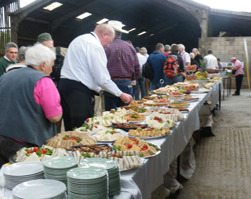
Our journey continued southbound on the A1 motorway. We passed by the exit for Thirsk, the village where author James Herriot lived. Just before the conference week I had read the biography of James Herriot (Alf Wight in real life) written by his son. I think I must have read all his books and the TV series, All Creatures Great and Small was one of my favourites when I was younger. I would have loved to have stopped for a visit in Thirsk, but maybe another time. We arrived at the Telford Hotel & Golf Club soon after 8pm.
The Conference
The next day myself and Chairman of our association, Lennart Andersson went to the WHC meeting which started at 8am after which there were lectures followed by country reports. The theme as I said before was Building the Brand.
The main speaker for the day, Marcia Dutra de Barcellos, is a professor in marketing and marketing strategies at the university of Brazil, Rio Grande do Sul. She said that the demand for quality beef is getting enormous and there is huge potential for the Hereford breed to produce the quality of beef that the markets are in need of regarding tenderness and taste. Beef of Hereford or Hereford cross has won competitions in Ireland and New Zeeland. Marcia also said that the demand for buying beef online from farm shops has increased, but that the consumer must be able to trust the consistency of the quality. You have to produce a product that stands out from the rest with regards to logo and design, traceability, quality guarantee for taste and tenderness, ethical treatment of the cattle like for instance raised outdoors on natural grass, slaughtered ethically and environmentally friendly (organic). When you produce a product like this, you must of course get paid well for it and that includes the producer and the shop that sells it.
A problem with starting a project like Hereford Beef can be providing the quantities needed. To encourage producers to supply beef all year round can be to offer a premium at the time of the year when the supply is at a low.
In countries where the Hereford Beef brand has been started, there are different criteria that the producers are required to meet. In New Zeeland for example, beef taken into the scheme must me at least 75% Hereford. In Ireland the requirement is 50% Hereford. There can also be requirements for carcass weight and sex of the cattle like only heifers and steers for example.
Robin Irvine, Chairman of the UK society is responsible for planning the theme for the conference,”Building the Hereford brand” as a registered trademark. He said that in 2010 a scheme was launched aimed to both the purebred and the commercial breeder where 5 GBP per calf and a maximum of 500GBP per year is paid the breeder from the society for calves born by bulls entered into the studbook with high EPDs for carcase traits.
Robin also told us that at the last three/four sales that Hereford bulls with high EPDs for carcase traits had been the highest selling bulls, and even taken champion titles and been class winners at shows.
Information from the member countries in short.
Some text courtesy of the UK society. Many thanks.
Brazil
Brazil was first out with their raport. Slaughter companies are begining go against raising cattle on land where rainforest has recently been deforestation. Sales of Hereford Prime has increased by 40% since 2003. Producers receive 3-15% higher price depending on carcass fat and conformation. The demand is higher than production.
Denmark
The Danish Hereford Association is going to work together with the Swedish Association on the export of Herefords to Europe, including Holland. The association reported over 9,000 cattle registered in 2009 in around 1,200 herds. Some 18 Hereford bulls were performance tested annually, with the best of these entering AI service.
Holland
The Dutch Association is working on in-herd linear scoring and performance testing. Most Hereford Beef is sold privately in boxes. There is no Hereford Prime program. Today there are 126 members.
Ireland
The demand for Herefords as breeding stock has increased due to Hereford Prime which sells in shops and restaurants. New producers are sought after all the time due to the high demand. A new website for Hereford Prime is in the making which will include a link to Facebook and the association is even working on a new farm sign with the logo to make the label more recognised.
Finland
Beef production in Finland was on the increase and of the country’s 55,000 suckler cows, some 8,500 were purebred Herefords. With a further 4,000 bulls, the Hereford is the most popular breed in the country, and used in both pure and cross-bred herds. A recent merger between the Finnish AI centre and the Danish-Swedish Viking Genetics was expected to improvement genetic evaluation and breed improvement, with many AI sires expected to be used across the three countries. The breed performed exceptionally well commercially and in the country’s largest auction, the average price of yearling Hereford bulls was €3,550 and the highest price was €6,100. For several years, a Hereford bull has attracted the highest price of all beef breeds. With the introduction of better branding, Finnish consumers are now able to buy supermarket beef carrying the Hereford brand and producer name.
Canada
The Canadian association informed us about the next World Hereford Conference in Calgary, June 2012. The Canadian Hereford Association is celebrating 150 in 2010. Advertising in the Hereford World magazine about genomic testing is still not allowed as the association does not yet see that all requirements have been met. All bulls used for breeding and donor cows, as well as semen from foreign bulls will be DNA tested for Hypotrichosis and the result entered on the pedigree document.
The Canadian association is working on a Hereford Prime program.
Switzerland
The first Herefords had come to Switzerland only 14 years ago and today, some 37 Hereford herds keep 337 cows and 37 bulls. Minimum performance standards and linear scoring had to be met for registered cattle and breeding goals were defined by a syndicate of breeders, founded in 2002.
The next European Conference is to be held in Switzerland
Great Britain
The Hereford Cattle Society in the UK reported a remarkable 95 per cent increase in Society membership over the past 10 years - a strong position that was reinforced by a trebling of movement recordings over the same period. The breed’s characteristics of temperament, calving ease, economics, and meat quality had all played a part in this transformation while the association with BreedPlan – now in its sixth year – was described as ‘the best and most important move we have made as a breed society’. Using BreedPlan data, the Superior Carcase Sire Scheme had been recently launched, offering cash incentives to purchasers of superior bulls. Although it would take some time before the message reached the target commercial user, three out of four sales since the launch were now topped by a ‘Superior Carcase Sire’.
Sweden
The Hereford breed is the second largest beef breed in numbers. With approximately 900 new registrations each year, the cattle must be weighed at birth and meet minimum weanling and yearling weights in order to be entered into the stud book. The association has 350 members. 30 Hereford bulls are performance tested annually and one has been chosen by Viking Genetics every year for the AI program, until this year when, due to the increase in demand for Hereford semen, two are now chosen. Sweden has a very high health status and can export cattle to almost all countries.

Shropshire show
The meeting finished slightly later than planned and we arrived at the nearby Shropshire show just after 2pm when judging of the Herefords began. Delegates ate a late lunch at the show, but I myself, grabbed a piece of sponge cake from the refreshments tent and ran to the ringside, not wanting to miss a minute! The judge was Mr Steve Edwards. I met Mr Edwards at the Agromek show in Herning, Denmark when he was judging and I was showing a bull calf that we had sold to a breeder in Denmark.
In the UK you can show females with or without calves at foot in the same class. I’m not sure how this is in the rest of the world. For me I think it must be difficult to judge a cow in production against one that is not.
The Shropshire Show was smaller than the Royal Highland, but being a neighbouring county to Herefordshire, there are a large number of Hereford Cattle entered for the show. The quality of cattle was very high and the judging was very interesting to watch on a hot, beautiful day in what felt to me like very familiar surroundings.
As at the Royal Highland, David D invited delegates to give out the rosettes, including my daughter Christel, who took Dad with her in.
The judging was over by about 6pm after which we went to the VIP marquee where a delicious Hog Roast awaited us.
Photos from the Shropshire Show. Click on them to enlarge
The Haven
The next and last day of the conference. We started off by visiting The Haven in Herefordshire. The Haven, established in 1822, is the oldest Hereford herd in the world to have been run by the same family. (The Leen is the oldest herd, established in 1780, but has changed owners several times) Today the Haven still only breeds horned Herefords and the herd tries to not bring in new blood. Only a few sires bred by others have been used in the herd.
The farm house and surrounding English countryside was phenomenal! It felt like I was in a Jane Austin film. Beautiful horned Hereford cattle grazing in front of the manor house on such a lovely day. It was not hard to day dream away and imagine a beautiful horse drawn carriage pull up in front of the house.
The family, dressed for Sunday church came out of the house and were helped up into the carriage by a servant. I heard the sound of gravel under the carriage wheels as the horses trotted on down the drive way… You know, just like in the TV series, Pride and Prejudice, for example…
We moved on to a group of cows and calves where Haven Cavalier was working. He really made an impression on me, very sound, muscled with a lot of eye appeal. The Society had set up a stand back at the farm where we could buy a lot of nice merchandise and we had refreshments before setting off for our last farm visit.
The Bosa Herd
Our next visit was to Bosa Herefords in Ledbury, Herefordshire. The first group of cattle we saw grazed an apple orchard. Cider is produced at Bosa and the cattle are partly used to keep the grass short in the orchards.
I really liked the type of cattle at Bosa, especially the udders and teats but also the overall type.
Back at the farm there had been a judging competition arranged. Four yearling bulls stood tied up, and in a pen there were four cows. Each had a letter painted on the rump. We wrote down our placings on a piece of paper with our names on it and put it in a box and the results were announced at coffee time. Jan Wills was the official judge for the cows and I think that David Prothero was the judge for the bulls. Only one person got both group’s right and that was GunBritt Dahlqvist from Sweden! After refreshments in the garden in front of the beautiful farm house at Bosa it was time to head back to the hotel.
Click on the photos to enlarge
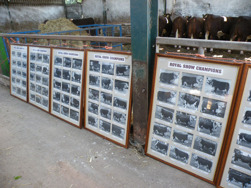
Gala dinner with a touch of Sweden.
Having had an awful cold the whole trip, no voice, and a high temperature, our chairman Lennart, commanded me to drink the little bottle of Whisky we had been given at Romany, on the way back to the hotel. Strange to think that none of the new people I had met would know how my real voice sounded (!)
Well back at the hotel, I just wanted to go to sleep, but I couldn’t miss the last event – the Gala Dinner. Hereford Beef from Waitros was on the menu after which an ABBA cover band was going to play for us! Waitros is a smaller but higher quality chain of supermarkets. They advertise and sell Hereford Prime Beef. I was exited to try it and I was not dissapointed! It was the best beef I had ever tasted at a restaurant before! The beef was so tender that you could have cut it with a spoon, and the taste was beyond words. As I was eating my favourite dessert, Cremé Brullé and eagerly waiting for the band to come on stage, our daughter fell asleep at the table…
To end...
The coach left the following morning at 06.45. On the 1 hour drive to where my mother would be picking us up, I couldn’t believe how fast the conference was over! It was a truly fabulous experience. We got to meet a lot of wonderful people, see great cattle and picturesque landscapes. I have been very inspired to go back to Sweden and do my best to start a Hereford Beef Scheme.
Just one thing worried me. How would I ever be able to put together a decent article for our Swedish Hereford Journal having been ill the whole time??? Well, I managed to put a few lines together apparently…!
Take care until we meet again,
Miranda

